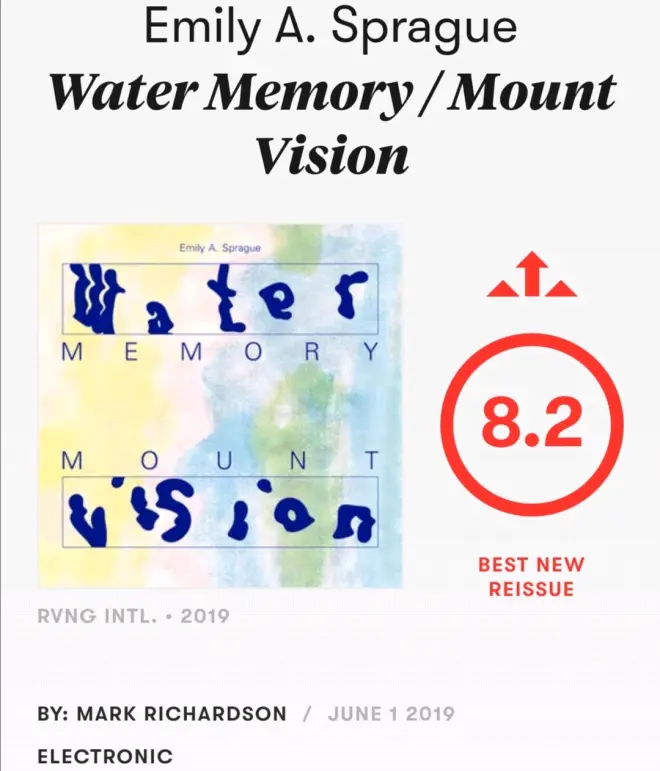【搬运译】Pitchfork评Emily A. Sprague2019年专辑Water Memory / Mount Visio
搬运自:微信公众号【评论搬一堆】(在原文基础上添加了英语原文与排版调整)
翻译:Lynn Liu
校对:Emma.Z
推送:Lynn Liu

The L.A.-based Sprague steps away from her indie pop trio Florist for rippling, patient, and redemptive ambient drone works for modular synthesizers.
洛杉矶的Sprague离开了她的独立流行三人乐队Florist,专注于为模块化合成器制作有起伏、有耐心、有救赎感的模糊背景音乐。
When Los Angeles-based musician Emily Sprague steps away from her folky indie pop trio Florist to make music with modular synthesizers, her music becomes a tool for perception. Listening to it, you start to notice things. Not just about what’s unfolding in the music itself, but also about what’s going on in the room where it plays, and maybe even what happens when the music stops.
洛杉矶的音乐家Emily Sprague离开她的民谣独立流行三人乐队Florist,并使用模块化合成器创作音乐时,她的音乐变成了一种感知的工具。听着它,你会开始注意到一些事情——不仅是音乐本身发生了变化,还有播放音乐的空间也发生了变化,甚至可能是音乐停止时都有可能发生变化。
Water Memory/Mount Vision collects two tapes of Sprague’s ambient music, both of which were created in the last two years, and frames them with brief spoken-word pieces. Along with artists like Kaitlyn Aurelia Smith, Sprague is part of a wave of artists returning ambient music to its spiritual roots, which is to say it’s not afraid of being called new age. Artists like Sprague often use old tools—modular synths instead of computers—and create spaces for relaxation and contemplation.
《Water Memory/Mount Vision》中收入了两碟Sprague近两年制作的氛围音乐,这张专辑中也包含了一些诵读音乐。像Kaitlyn Aurelia Smith这类艺术家一样,Sprague将氛围音乐回归到其精神根源,她是艺术家浪潮的一部分。也就是说,氛围音乐并不害怕被称为新时代。像Sprague这样的艺术家经常使用旧的工具——模块化合成器,而不是电脑,这样能为放松和沉思创造空间。
Sprague is more or less a minimalist, but her work also carries hints of tension. She’s especially adept at taking two compelling elements and exploring how they interact, finding a third “thing” that ultimately becomes the piece. “A Lake,” a slowly unwinding drone consisting of a throbbing bass tone at the bottom and shimmers of high-pitched tones at the top, uncannily evokes the body of water in its title, hinting at lights on a rippling surface and an invisible world spreading out beneath. Its beauty brings to mind the lyricism of Takagi Masakatsu, but Sprague composes with more patience, content to let held tones linger in place for minutes at a time. The primary motif in “Water Memory 1” is a rising and repeating synth tone. Set against a sound that recalls a French horn, it vaguely suggests an orchestrated waltz that got stuck in place, not unlike William Basinki’s Disintegration Loops, but hopeful rather than forlorn.
在某种程度上来说,Sprague是个极简主义者,但她的作品也带有一丝紧张感。她尤其擅长将两种吸引人的元素结合起来,探索它们之间的相互作用,找到最终能构成音乐的第三个“元素”。“A Lake”是一首缓慢循环的模糊音乐,底部是激动的低音,顶部是闪烁的高音。让人惊讶的是,这样的音乐居然与专辑名中的“水(water)”相对应,它暗示着水面上的粼粼波光,以及水下的未知世界。它的美让人想起高木正胜的抒情,但Sprague的作曲更有耐心,满足于让同一个音调在曲子里一次多停留几分钟。“Water Memory 1”满布上升重复的合成器,让人想起与之相反的法国圆号声,这首曲子听着隐约像是一首被卡住的管弦乐华尔兹,有点像William Basinki的作品《Disintegration Loops(瓦解循环)》,但Sprague的音乐充满希望,而不是绝望。
The Mount Vision half is a shade darker, and also finds Sprague incorporating acoustic sounds. “Synth 1” and “Synth 2” are more focused and intense and also a touch more psychedelic, their fat drones bringing to mind outer space instead of the natural world. The bubbling “Huckleberry” is suggestive of Suzanne Ciani, demonstrating how in the right hands electricity moving through a modular set-up can sound uncannily alive.
专辑的下半部分“Mount Vision”充满了暗色调,我们也发现Sprague在里面融入了声学声音。“Synth 1”和“Synth 2”更专注、更强烈,还有一点更迷幻的感觉。其中大范围的模糊音色让人想到了外太空,而不是想到自然界。沸腾的“Huckleberry”让人联想起Suzanne Ciani,它展示了当电流通过一个模块化合成器时,音乐听起来可能会异常活跃。
“Piano 1” sounds like a recording of the instrument falling apart in slow motion, as Sprague takes a repeating keyboard phrase and pulls it apart taffy, finding a sense of wonder through subtle shifts in tempo and EQ. A variation of the track, “Piano 2,” closes the set, and features the piano sounds mixing with recordings of birds and insects. As it unfolds, a second recording of the piano part appears, slightly out of phase with the first, and the gaps in the notes become longer and it takes on an oblong gait, like a limp. These small, subtle changes define this music. When you return to silence after it’s over, you start to think about what else you might be missing.
“Piano 1”听起来像乐器的录音慢慢变得支离破碎, Sprague使用一个重复的键盘乐句,就像拆开太妃糖一样,我们能透过微妙的节奏与情感变化发现一种惊奇感。这首曲子的变奏是“Piano 2”,曲子没有使用合成器,而是将钢琴的音色与鸟类和昆虫的录音相混合。随着乐曲的展开,钢琴部分的第二段录音出现了,与第一段有点不协调:音符的间隙变长了,呈现出一种椭圆的步态,就像跛足前行。这些细微的变化定义了这种音乐。当音乐结束后回归沉默时,你便开始思考,你是否可能还错过什么。

